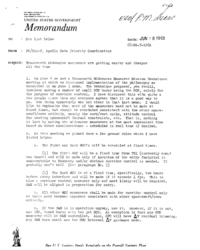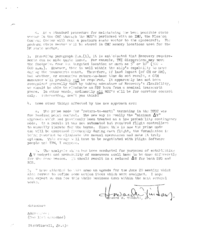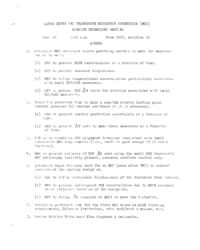Upthread: Transearth midcourse correction philosophy – a major operation break through! (Jun 03, 1968)
Downthread: Need to know some transearth midcourse correction (MCC) ΔV costs (Jun 28, 1968)
See list belowJUN 18 196868-PA-T-126APA/Chief, Apollo Data Priority CoordinationTransearth midcourse maneuvers are getting easier and cheaper all the time
1. On June 6 we had a Transearth Midcourse Maneuver Mission Techniques meeting at which we discussed implementation of the philosophy as described in my June 3 memo. The technique proposed, you recall, involves making a number of small RCS burns using the SCS, solely for the purpose of corridor control. I have discussed this with quite a few people since then and everyone agrees that it is a good way to go. One thing apparently was not clear in that last memo. I would like to emphasize that most of the maneuvers need not be made at fixed times, but should be scheduled consistent with the other space- craft/crew activity, namely the work/rest cycle, attitude control for meeting spacecraft thermal constraints, etc. That is, nothing is lost by making the midcourse maneuvers at the most convenient time based on other considerations – scheduled in real time if desired.
2. At this meeting we pinned down a few ground rules which I have listed below:
a. The first and last MCC's will be scheduled at fixed times.
(1) The first MCC will be a fixed time from TEI (currently about ten hours) and will be made only if location of the entry footprint is unacceptable to Recovery and/or obvious corridor control is needed. It probably won't be!! (See paragraph No. 3)
(2) The last MCC is at a fixed time, specifically, two hours before entry interface and will be made if it exceeds 1 fps. This is also a corridor control maneuver only and most likely will be required. G&N will be aligned in preparation for entry.
b. All other MCC maneuvers shall be made for corridor control only as their need becomes apparent consistant with other spacecraft/crew activity.
c. If the G&N is in operation anyway, use it. However, if it is not, use SCS, timed burns with two jet RCS. An exception is that any SPS maneuver will be G&N controlled. Also, SPS will have ΔV residual trimming. Any G&N burn shall use the CMC External ΔV guidance mode.
d. As a standard procedure for maintaining the best possible state vector in the CMC through the MCC's performed with no IMU, the Mission Control Center will send a postburn state vector to the spacecraft. The preburn state vector will be stored in CMC memory locations used for the LM state vector.
3. Regarding paragraph 2.a.(1), it is anticipated that Recovery require- ments can be made quite loose. For example, TEI dispersions may move the footprint from its targeted location as much as 5° or 10° (300 – 600 n.m.). However, this is well within the ship's capability to move during the transearth coast. Therefore, if land impact (of CM or SM), bad weather, or excessive return-to-base time do not result, a CSM maneuver will probably not be required. It apparently has not been recognized generally that by taking advantage of Recovery's flexibility, we should be able to eliminate an SPS burn from a nominal transearth phase. In other words, ordinarily all MCC's will be for corridor control only. Interesting, don't you think?
4. Some other things affected by the new approach are:
a. The prime mode for “return-to-earth” targeting in the RTCC was for landing point control. The new way is really the “minimum ΔV” approach which had previously been treated as a low probability contingency mode. As a result it was not automated but required flight controllers to manually iterate for the burns. Since this is now the prime mode and will be exercised frequently during each flight, the formulation is being reworked to eliminate the manual operations and make it truly optimum. This change well have to be negotiated with Flight Software people and IBM, I suppose.
b. The analysis which has been conducted for purposes of establishing ΔV budgets and probability of maneuvers shall have to be done differently for the same reason. It should result in a reduced ΔV for both SPS and RCS.
5. I have attached to this memo an agenda for the June 20 meeting which also serves to define some action items which were assigned. I hope and expect we can ice this whole business down within the next several weeks.
LUNAR ENTRY AND TRANSEARTH MIDCOURSE CORRECTION (MCC) MISSION TECHNIQUES MEETING
June 20 9:00 a.m. Room 3068, Building 30
AGENDA
1. Establish MCC threshold valves governing whether to make the maneuver now or to wait.
(a) MPB to present MSFN uncertainties as a function of time.
(b) GPB to present maneuver dispersions.
(c) MPD to define computational uncertainties particularly associated with small RCS/SCS maneuvers.
(d) GPB to present RCS ΔV costs for activity associated with small RCS/SCS maneuvers.
2. Establish preferred time to make a non-G&N reentry landing point control maneuver for weather avoidance if it is necessary.
(a) LRD to present weather prediction uncertainty as a function of time.
(b) MAB to present ΔV cost to make these maneuvers as a function of time.
3. FDB is to establish SCS alignment technique consistant with small transearth MCC requirements (i.e., crude is good enough if it saves anything).
4. MAB to present estimate of RCS ΔV cost using the multi SCS transearth MCC philosophy currently planned, assuming corridor control only.
5. Establish logic defining need for an MCC (soon after TEI) to control location of the landing footprint.
(a) LRD to define acceptable displacement of the footprint from nominal.
(b) MPB to present anticipated TEI uncertainties due to MSFN accuracy which influence location of the footprint.
(c) MPB to define ΔV required at MCC1 to move the footprint.
6. Establish preferred time for the first MCC based on MSFN tracking requirements, Colossus limitations, crew work/rest timeline, etc.
7. Review Mission Techniques Flow diagrams & rationale.
- Jun 03, 1968 – Transearth midcourse correction philosophy – a major operation break through! (9.0σ)
- Jun 28, 1968 – Need to know some transearth midcourse correction (MCC) ΔV costs (5.7σ)
- Sep 20, 1968 – C’ Transearth Midcourse Correction (MCC) and Entry Mission Techniques (4.0σ)
- Oct 07, 1968 – Cis-lunar spacecraft navigation for C’ (3.5σ)



